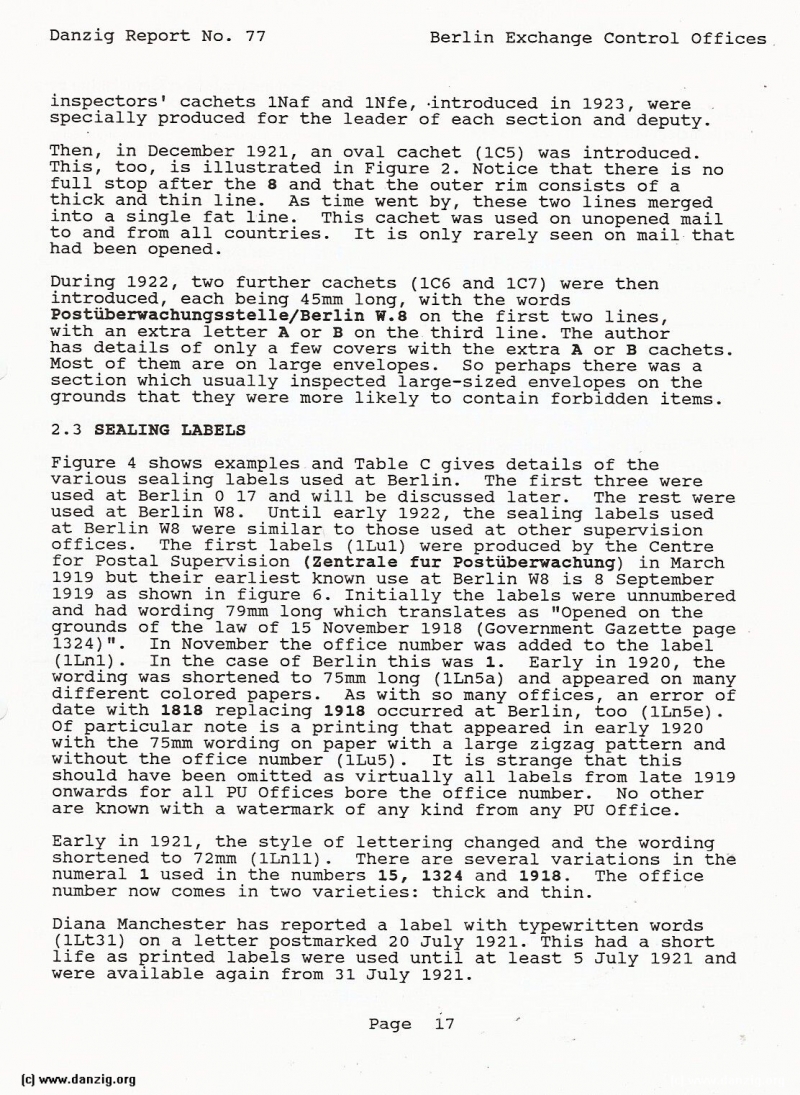
inspectors’ cachets iNaf and lNfe, •introduced in 1923, were specially produced for the leader of each section and deputy. Then, in December 1921, an oval cachet (1C5) was introduced. This, too, is illustrated in Figure 2. Notice that there is no full stop after the 8 and that the outer rim consists of a thick and thin line. As time went by, these two lines merged into a single fat line. This cachet was used on unopened mail to and from all countries. It is only rarely seen on mail that had been opened.
During 1922, two further cachets (1C6 and 1C7) were then introduced, each being 45mm long, with the words Postüberwachungsstelle/Berlin W.8 on the first two lines, with an extra letter A or B on the third line. The author has details of only a few covers with the extra A or B cachets. Most of them are on large envelopes. So perhaps there was a section which usually inspected large-sized envelopes on the grounds that they were more likely to contain forbidden items.
2.3 SEALING LABELS
Figure 4 shows examples and Table C gives details of the various sealing labels used at Berlin. The first three were used at Berlin 0 17 and will be discussed later. The rest were used at Berlin W8. Until early 1922, the sealing labels used at Berlin W8 were similar to those used at other supervision offices. The first labels (iLul) were produced by the Centre for Postal Supervision (Zentrale fur Postüberwachung) in March 1919 but their earliest known use at Berlin W8 is 8 September 1919 as shown in figure 6. Initially the labels were unnumbered and had wording 79mm long which translates as “Opened on the grounds of the law of 15 November 1918 (Government Gazette page 1324)”. In November the office number was added to the label (iLni). In the case of Berlin this was 1. Early in 1920, the wording was shortened to 75mm long (lLn5a) and appeared on many different colored papers. As with so many offices, an error of date with 1818 replacing 1918 occurred at Berlin, too (lLn5e). Of particular note is a printing that appeared in early 1920 with the 75mm wording on paper with a large zigzag pattern and without the office number (lLu5). It is strange that this should have been omitted as virtually all labels from late 1919 onwards for all PU Offices bore the office number. No other are known with a watermark of any kind from any PU Office.
Early in 1921, the style of lettering changed and the wording shortened to 72mm (lLnll). There are several variations in the numeral 1 used in the numbers 15, 1324 and 1918. The office number now comes in two varieties: thick and thin.
Diana Manchester has reported a label with typewritten words (lLt3l) on a letter postmarked 20 July 1921. This had a short life as printed labels were used until at least 5 July 1921 and were available again from 31 July 1921.
Danzig Report Vol. 1 - Nr. 77 - October - November - December - 1992, Page 17.
Hits: 3588
Added: 03/07/2015
Copyright: 2025 Danzig.org

